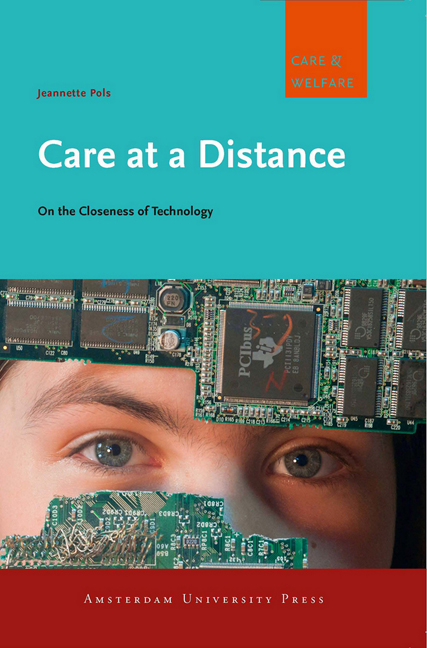Book contents
- Frontmatter
- Contents
- Nightmares, Promises and Efficiencies in care and Research
- Part I Norms and Nightmares
- Part II Knowledge and Promises
- Part III Routines and Efficiencies
- Conclusions: On Studying Innovation
- Acknowledgements
- Appendix: Projects Studied for this Book
- Notes
- References
- Index of Names
- Index of Subjects
3 - The Heart of the Matter: Good Nursing at a Distance
Published online by Cambridge University Press: 03 February 2021
- Frontmatter
- Contents
- Nightmares, Promises and Efficiencies in care and Research
- Part I Norms and Nightmares
- Part II Knowledge and Promises
- Part III Routines and Efficiencies
- Conclusions: On Studying Innovation
- Acknowledgements
- Appendix: Projects Studied for this Book
- Notes
- References
- Index of Names
- Index of Subjects
Summary
Goodness of fit
The metaphors of warm and cold point to the affective quality of relations between carers, devices and patients, where warm refers to loving, good and well liked, and cold to unfeeling or neutral at best. Metaphors of temperature drag along with them a set of influential yet – in care practice – untenable oppositions, separating the objective from the subjective, the technical from the human, the ethical from the epistemological, and ultimately: the good from the bad. I have suggested a practical aesthetics of fitting as a way to avoid this opposition.
The aesthetic verb ‘fitting’, however, may imply that fitting is about authentic relations between individuals. Instead of the system world invading the life world, everything would consist of intersubjective relations, including relations with devices. This is not a position I would want to end up in. In this chapter I hope to show that fitting is not a mere matching of people (or people and devices) but is situated in practices that include other devices, bodies, ideas about the world and – the focus of this chapter – norms that define good care. For instance, in the aesthetics of palliative care for people with incurable cancer, far more professional care is deemed fitting than, say, in the care for people with COPD or heart failure. The latter demands – and deems appropriate – more activity and initiative from patients. Fitting care may aim for patient independence in some situations, whereas it would mean close professional monitoring in others.
In other words, fitting care is not merely dependent on the satisfaction of the participants, it also takes shape by aligning care to the norms that define good care. I understand norms of good care as values (say: good relations, independence, cut-off points that define deviations) combined with directives for what to do and who should do it (call or see a patient, ask a patient to measure vital signs, prescribe medication). Both values and directives are built into telecare devices as well as activities of professionals and patients or in the ways they enact good care. One needs to ask whether the human participants see their acts as good or not, or analyse their activities as I do with the activity of devices, that is, within the logic of the practice in which they are used.
- Type
- Chapter
- Information
- Care at a DistanceOn the Closeness of Technology, pp. 45 - 60Publisher: Amsterdam University PressPrint publication year: 2012



